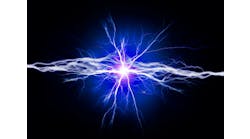Explosive environments pose unique challenges for any type of automation equipment, but, because most human-machine interfaces (HMIs) have some type of display, there are unique issues for this piece of equipment. The applicable definitions and rules for locating equipment in these areas are regulated by either the National Electrical Code (NEC) in the United States or the Atmosphères Explosibles (AtEx) directives for most of the rest of the world.
Both systems allow for three main approaches to locating any type of control hardware safely in explosive gas or dust areas to prevent fire and explosion:
• limit the power to the devices so ignition cannot occur—intrinsically safe (IS)
• allow combustibles in, but contain any resulting explosion within the control enclosure—explosion proof
• use inert gas purging to prevent explosive gas or particulates from getting into cabinets or devices in the first place.
Intrinsically safe is a valid approach to low-power devices, such as sensors, and is used quite effectively every day in many different situations. The power demands of HMIs, however, make this approach a near impossibility for a user display. And, if IS-certified HMIs do exist, I’m sure the cost is nothing short of extraordinary.
Explosion-proof enclosures are effective for using standard components in Class I or Zone 1 environments but very cumbersome, very expensive and very unfriendly to HMI displays. It is and can be done, but, by most accounts, it is not a preferred method for an HMI.
This leaves us with purge and pressurized systems. This approach is quite simple in principle: The enclosure is pressurized with clean air or inert gas, which prevents explosive gas or dust from entering in the first place. It creates a non-explosive mini-environment inside the enclosure.
For the machine designer, this means, depending on the type of purge system and pressure/flow controller used, standard nonhazardous-rated equipment can be used in the enclosure, even up to Class I/Zone 1 for NEC, and Zone 1 for ATEX. Additionally, there are numerous vendors of HMI panels that have purge systems built-in. All the machine designer has to do is supply instrument air and power, and the system has a bona fide purge HMI.
There are two types of purging systems for enclosures—continuous flow (CF) and leakage compensation (LC). Both systems use a flow controller to maintain a minimum pressure or flow to the enclosure, and both have some level of intelligence. It is how they handle and measure the gas flow that is the difference.
Both systems require a separate purge phase for expelling any initial explosive gases prior to energizing equipment and then a pressure phase that maintains the protective gas supply during running of the equipment.
Continuous flow is a somewhat simpler method, but only applicable to smaller enclosures less than 17 sq ft. In CF systems, a continuous flow of protective gas is supplied to the enclosure at a rate that maintains a minimum internal pressure, but the flow is the same during the initial purge phase and the normal pressure state. This can result in very long purge times prior to energizing the equipment in the enclosure. Less functionality in the pressure controller is required, so the initial controller cost is lower, but, since the combined purge and running flow is high, this system consumes more air than the LC approach, so long-term costs are higher.
Leakage-compensation systems use a specialized flow controller that gives a higher rate of gas during the purge phase than it does during pressurized running state, so running air flow is lower, and the system consumes less instrument air. The controller is more expensive, but long-term costs are lower as a result of less air usage.
One of the main drawbacks of purge and pressure systems is the cost and complexity of supplying the required protective gas. Although inert gases, such as nitrogen, can be used at even higher cost, the typical implementation uses instrument-quality air, which is dry, clean air from outside the hazardous location. Although not bank-breaking, the cost is not insignificant to purchase the system, pipe the initial installation and maintain it.
Specifically for HMIs, if the interface is a touchscreen, there may be some challenges to designing the enclosure to allow access to a touchscreen, while maintaining a seal for the protective gas inside. These enclosures are available for most common touchpanel sizes, but keep in mind that HMI doesn’t always imply touchscreen; there are other user input devices such as pushbuttons, soft button pads or mice and keyboards, which can be found with IS certifications.
There are side benefits to purge systems, even for nonhazardous areas. Simply the act of supplying air into the enclosure will help cool the internal equipment of the enclosure. This is a huge benefit for installations that are close to their designed temperature specs.
Another benefit comes from the cleanliness of the internals of the enclosure. With clean air preventing any dust or other chemicals from entering the enclosure, the electronics do not suffer from dust or chemical residue, aiding in extending the life of the components inside.





